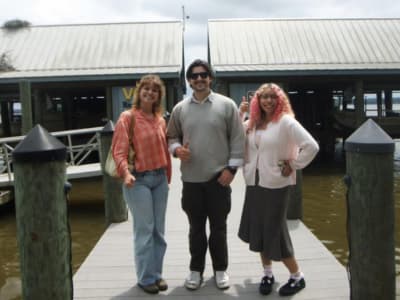What inspires a student to turn curiosity about the environment into campus-wide change? For Environmental Studies major Yelena Sanyer, it started with a walk to Belle Isle.
Sept. 8, 2025

When Yelena Sanyer first arrived at VCU, she wasn’t sure which academic path she wanted to follow. “Coming into VCU, my major was ‘undecided’ and I was taking general education classes to see what interested me most,” she recalled. But a walk to Belle Isle with members of VCU’s SEEDS chapter (The Strategies for Ecology Education, Diversity, and Sustainability) changed everything.
“Through talking to the officers and learning about the rock pools, I was inspired,” Sanyer said. Not long after, she enrolled in the sociology course Confronting Climate Crisis. The experience of volunteering at a community garden and creating advocacy projects on campus solidified her decision. “I enjoyed it so much that I decided I’d never stop.”
That decision led her to declare Environmental Studies as her major, a choice that has since opened the door to leadership roles, meaningful projects, and an internship with VCU Sustainability.
On campus, Sanyer now serves as president of VCU SEEDS, the very organization that first inspired her. “After the impact the club left on me, I wanted to take on a leadership role and share these opportunities with more students,” she said. She also finds time to attend STEM in Art and Scientific Illustration club meetings and volunteers with the Department of Conservation and Recreation’s Natural Heritage Zoology lab.
This past summer, her passion for environmental work extended beyond student organizations into a hands-on internship with VCU Sustainability. One highlight of her experience was transforming the “Cumberland wedge”, a plain patch of grass behind the Cary Street Field, into a thriving native plant meadow.
“What was once a plain lawn became a hub of biodiversity and a refuge for pollinators,” Sanyer said. “In the spring, hundreds of ladybug larvae were growing. By summer, the grass had matured and the flowers were in full bloom.” The project, she hopes, will serve as a model for future conservation efforts on campus.
The internship also deepened the connection between her coursework and practical experience. She observed pollinator-plant interactions, studied the impact of invasive species, and saw firsthand how stormwater retention gardens improve urban spaces. Just as importantly, she learned the value of collaboration. “I was shown the importance of communicating with local organizations and the community when it comes to starting an urban ecology project.”
The most rewarding moments came when she could see her team’s hard work pay off in living color. “Seeing the Cumberland Wedge covered in bright yellow Black-Eyed Susans was my favorite because of the amount of work that went into transforming that space,” she said. She also fondly remembers harvesting fruits and vegetables from the learning garden.
Beyond the immediate projects, the experience has shaped her future goals. “This internship strengthened my love for native plants and pollinators and showed me that even small projects can make a significant difference,” she said. Networking with master gardeners and organizations like the Alliance for the Chesapeake Bay and the James River Association also gave her a glimpse of the professional possibilities ahead.
“Now that I have a new interest in urban ecology, I’d like to get involved in local organizations like this and maybe pursue a career in ecological horticulture, where I can design public green spaces to be sustainable, beautiful, and beneficial to the local ecosystem.”
From an undecided first-year student to a leader, advocate, and aspiring ecological horticulturist, Sanyer’s story is a reminder of how curiosity, community, and commitment can transform a path and an ecosystem.